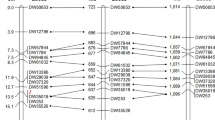Abstract
Quantitative trait loci influencing fruit traits were identified by restriction fragment length polymorphism (RFLP) analysis in a population of recombinant inbred lines (RIL) derived from a cross of the cultivated tomato, Lycopersicon esculentum with a related wild species Lycopersicon cheesmanii. One hundred thirty-two polymorphic RFLP loci spaced throughout the tomato genome were scored for 97 F8 RIL families. Fruit weight and soluble solids were measured in replicated trials during 1991 and 1992. Seed weight was measured in 1992. Significant (P<0.01 level) quantitative trait locus (QTL) associations of marker loci were identified for each trait. A total of 73 significant marker locus-trait associations were detected for the three traits measured. Fifty-three of these associations were for fruit weight and soluble solids, many of which involved marker loci signficantly associated with both traits. QTL with large effects on all three traits were detected on chromosome 6. Greater homozygosity at many loci in the RIL population as compared to F2 populations and greater genomic coverage resulted in increased precision in the estimation of QTL effects, and large proportions of the total phenotypic variance were explained by marker class variation at significant marker loci for many traits. The RIL population was effective in detecting and discriminating among QTL for these traits previously identified in other investigations despite skewed segregation ratios at many marker loci. Large additive effects were measured at significant marker loci. Lower fruit weight, higher soluble solids, and lower seed weight were generally associated with RFLP alleles from theL. cheesmanii parent.
Similar content being viewed by others
References
Beavis WD, Grant D, Albertson M, Fincher R (1991) Quantitative trait loci for plant height in four maize populations and their associations with qualitative genetic loci. Theor Appl Genet 83: 141–147
Burr B, Burr FA, Thompson KH, Albertson MC, Stuber CW (1988) Gene mappingwith recombinant inbreds in maize. Genetics 18:519–526
De Vicente MC, Tanksley SD (1993) QTL analysis of transgressive segregation in an interspecific tomato cross. Genetics 134:585–596
Edwards MD, Stuber CW, Wendel JF (1987) Molecular-marker facilitated investigations of quantitative trait loci in maize I. Numbers, genomic distribution and types of gene action. Genetics 116:113–125
Edwards MD, Helentjaris T, Wright S, Stuber CW (1992) Molecular-marker-facilitated investigation of quantitative trait loci in maize. 4. Analysis based on genome saturation with isozyme and restriction fragment length polymorphism markers. Theor Appl Genet 83: 765–774
Emery GC, Munger HM (1970) Effect of inherited differences in growth habit on fruit size and soluble solids in tomato. J Am Soc Hort Sci 95:410–412
Eshed Y, Zamir D (1994) Introgressions from Lycopersicon pennellii can improve soluble solids yield of tomato hybrids. Theor Appl Genet 88:891–897
Falconer DS (1981) Introduction to quantitative genetics. Longman Scientific and Technical, London
Goldman IL, Rocheford TR, Dudley JW (1993) Quantitative trait loci influencing protein and starch concentration in the Illinois Long Term Selection maize strains. Theor Appl Genet 87:217–224
Ibarbia EA, Lambeth VN (1969) Inheritance of soluble solids in a large/small-fruited tomato cross. J Am Soc Hort Sci 94:496–498
Lander E, Botstein D (1989) Mapping mendelian factors underlying quantitative traits using RFLP linkage maps. Genetics 121: 185–199
Mansur LM, Orf J, Lark KG (1993) Determining the linkage of quantitative trait loci to RFLP markers using extreme phenotypes of recombinant inbreds of soybean (Glycine max L. Merr.). Theor Appl Genet 86:914–918
Nienhuis J, Helentjaris T (1989) Simultaneous selection for multiple polygenic traits through RFLP analysis. In: Helentjaris T, Burr B (eds) Cold Spring Harbor symposium: development and application of molecular markers to problems in plant breeding. Cold Spring Harbor, NY, pp 107–112
Nienhuis J, Helentjaris T (1990) Application of molecular marker technology to tomato improvement. Acta Hortic 277:39–46
Osborn TC, Alexander DC, Fobes JF (1987) Identification of restriction fragment length polymorphisms linked to genes controlling soluble solids in tomato fruit. Theor Appl Genet 73:350–356
Paran I, Goldman IL, Tanksley SD, Zamir D. Recombinant inbred lines for genetic mapping in tomato. Submitted
Paterson AH, Lander ES, Hewitt JD, Peterson S, Lincoln SE, Tanksley SD (1988) Resolution of quantitative traits into Mendelian factors, using a complete linkage map of restriction fragment length polymorphisms. Nature 355:721–726
Paterson AH, Deverna JW, Lanini B, Tansksley SD (1990) Fine mapping of quantitative trait loci using selected overlapping recombinant chromosomes, in an interspecies cross of tomato. Genetics 28:379–392
Paterson AH, Damon S, Hewitt JD, Zamir D, Rabinowitch HD, Lincoln SE, Lander SE, Tanksley SD (1991) Mendelian factors underlying quantitative traits in tomato: comparison across species, generations, and envrionments. Genetics 127:181–197
Rick CM (1974) High soluble-solids content in large-fruited tomato lines derived from a wild green-fruited species. Hilgardia 42:493–510
SAS Institute, Inc (1988) SAS user's guide: statistics. SAS Institute, Cary, N.C.
Shrimpton AE, Robertson A (1988) The isolation of polygenic factors controlling bristle score in Drosophila melanogaster. II. Distribution of third chromosome bristle effects within chromosome sections. Genetics 118:445–459
Soller M, Brody T (1976) On the power of experimental designs for the detection of linkage between marker loci and quantiative loci in crosses between inbred lines. Theor Appl Genet 47:35–39
Tanksley SD, Ganal MW, Prince JP, DeVicente MC, Bonierbale MW, Broun P, Fulton TM, Giovanonni JJ, Grandillo S, Martin GB, Messeguer R, Miller JC, Miller L, Patterson AH, Pineda O, Roder M, Wing RA, Wu W, Young ND (1992) High density molecular linkage maps of the tomato and potato genomes: biological inferences and practical applications. Genetics. 132:1141–1160
Tanksley SD, Hewitt J (1988) Use of molecular markers in breeding for soluble solids content in tomato ⊕ re-examintaion. Theor Appl Genet 75:811–823
Zamir D, Tadmor Y (1986) Unequal segregation of nuclear genes in plants. Bot Gaz 147:355–358
Author information
Authors and Affiliations
Additional information
Communicated by M. Koornneef
Rights and permissions
About this article
Cite this article
Goldman, I.L., Paran, I. & Zamir, D. Quantitative trait locus analysis of a recombinant inbred line population derived from a Lycopersicon esculentum x Lycopersicon cheesmanii cross. Theoret. Appl. Genetics 90, 925–932 (1995). https://doi.org/10.1007/BF00222905
Received:
Accepted:
Issue Date:
DOI: https://doi.org/10.1007/BF00222905




